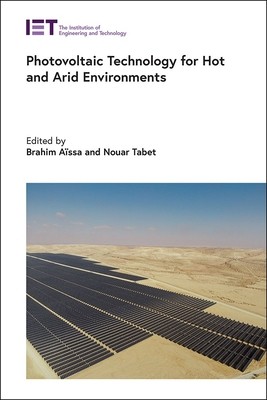
- We will send in 10–14 business days.
- Publisher: Institution of Engineering & Technology
- ISBN-10: 178561911X
- ISBN-13: 9781785619113
- Format: 15.6 x 23.4 x 2.1 cm, kieti viršeliai
- Language: English
- SAVE -10% with code: EXTRA
Photovoltaic Technology for Hot and Arid Environments (e-book) (used book) | bookbook.eu
Reviews
Description
The need to reduce greenhouse gas emissions and dependency on fossil fuels necessitates accelerated deployment of renewable energy, such as photovoltaics (PV). Regions with high insolation in the "Sun Belt" covering north Africa and the middle east, as well as in Australia, parts of Latin America, and elsewhere offer tremendous potential for PV, including for green hydrogen production. However, these regions are characterized by a hot climate and a dusty environment, both causing reduction of PV panel performance by 25% or more. The development of solar cells with enhanced resistance to thermal degradation and the reduction of panel soiling have therefore been subjects of intense study.
Key developments include optimisation of the temperature coefficient of heterojunction solar cells, developing cells of higher open circuit voltage that are expected to show lower reduction of the panel efficiency at high temperatures, and analysis of soiling effects for better predictability and countermeasures. Chapters revise solar energy resources and PV principles and thermodynamics, solar cell and module technology, bifacial solar cells, and soiling. A case study from Australia is followed by conclusions and an outlook.
Photovoltaic Technology for Hot and Arid Environments covers developments in the field for researchers and experts in industry and academia, and advanced students with an interest in the topic.
EXTRA 10 % discount with code: EXTRA
The promotion ends in 21d.10:40:07
The discount code is valid when purchasing from 10 €. Discounts do not stack.
- Publisher: Institution of Engineering & Technology
- ISBN-10: 178561911X
- ISBN-13: 9781785619113
- Format: 15.6 x 23.4 x 2.1 cm, kieti viršeliai
- Language: English English
The need to reduce greenhouse gas emissions and dependency on fossil fuels necessitates accelerated deployment of renewable energy, such as photovoltaics (PV). Regions with high insolation in the "Sun Belt" covering north Africa and the middle east, as well as in Australia, parts of Latin America, and elsewhere offer tremendous potential for PV, including for green hydrogen production. However, these regions are characterized by a hot climate and a dusty environment, both causing reduction of PV panel performance by 25% or more. The development of solar cells with enhanced resistance to thermal degradation and the reduction of panel soiling have therefore been subjects of intense study.
Key developments include optimisation of the temperature coefficient of heterojunction solar cells, developing cells of higher open circuit voltage that are expected to show lower reduction of the panel efficiency at high temperatures, and analysis of soiling effects for better predictability and countermeasures. Chapters revise solar energy resources and PV principles and thermodynamics, solar cell and module technology, bifacial solar cells, and soiling. A case study from Australia is followed by conclusions and an outlook.
Photovoltaic Technology for Hot and Arid Environments covers developments in the field for researchers and experts in industry and academia, and advanced students with an interest in the topic.


Reviews